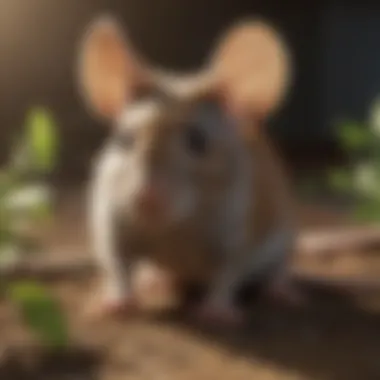Advanced Strategies for Eradicating Mice Infestation in Your Home


Preventive Pest Control Strategies
When it comes to keeping your home free from unwanted pests like mice, preventive measures play a crucial role. Housewives and homeowners need to be vigilant in implementing strategies that deter these nuisances from invading their living spaces. One fundamental aspect of preventive pest control involves safeguarding the exterior of your house. This includes diligently sealing any cracks or openings that could serve as entry points for mice, clearing debris around the perimeter of your property, and employing methods to prevent pests from getting inside.
Furthermore, maintaining a well-kept yard is essential in minimizing the risk of a pest infestation. Regular yard care routines such as mowing the lawn, trimming bushes, and removing standing water can help to create a less hospitable environment for mice and other pests. Additionally, implementing measures to keep yards pest-free, such as using natural repellents or installing barriers, can further enhance your pest control efforts.
Indoor cleanliness is another key factor in pest prevention. Housewives and homeowners should focus on expert cleaning tips and techniques to eliminate potential nesting sites for mice. This includes regularly decluttering, vacuuming, and disinfecting, which can help in maintaining a pest-resistant indoor environment.
Proper garbage disposal is also critical in deterring pests like mice from infesting your home. Using efficient waste disposal methods, such as tightly sealing garbage bins and composting organic waste properly, can prevent these scavengers from being attracted to your property. Educating yourself on the importance of correct garbage disposal practices is paramount in overall pest control.
Finally, exploring innovative ways to safeguard your home against pests can provide an added layer of protection. This may include using electronic repellent devices, planting pest-repelling vegetation around your property, or seeking professional advice on pest-proofing your living space. By incorporating these preventive measures into your pest control routine, you can significantly reduce the likelihood of a mice infestation in your home.
Understanding the Behavior of Mice
Mice infestation can be a nuisance for homeowners, leading to property damage and health risks. Understanding the behavior of mice is crucial in effectively combating infestations. By knowing how mice enter homes and their habits, one can implement targeted strategies to eliminate them. This section will delve into identifying common entry points and behavioral patterns of mice to provide a comprehensive guide for homeowners seeking to rid their homes of these pests.
Identifying Common Entry Points
One of the key aspects of mouse infestation is understanding the common entry points they use to access homes. Gaps in walls and floors are prevalent entry points for mice, allowing them to squeeze through tiny openings. These gaps provide easy access for mice to infiltrate homes, making them a primary concern for homeowners. Inspecting and sealing these gaps is essential in preventing mice from entering and nesting inside the house.
In addition to gaps in walls and floors, openings around plumbing fixtures are another favored entry point for mice. Mice can easily maneuver through gaps around pipes, seeking shelter and food inside homes. Identifying and sealing these openings is crucial in closing off access points for mice, effectively deterring them from establishing nests within the house.
Behavioral Patterns of Mice
Understanding the behavioral patterns of mice is key to developing successful pest control strategies. Mice are nocturnal creatures, primarily active during the night when homeowners are less likely to spot them. This nocturnal behavior allows mice to forage for food and build nests undisturbed, making them challenging to detect.
Nesting habits also play a significant role in mouse infestation. Mice have a tendency to create nests in secluded areas within homes, using soft materials like paper and fabric to build their nests. By recognizing these nesting habits, homeowners can locate potential nest sites and take proactive measures to eliminate them, disrupting the mice's living environment and reducing reproduction rates.


Preventive Measures to Keep Mice Away
Preventive measures play a crucial role in eliminating mice infestation in your home. By taking proactive steps, you can significantly reduce the chances of mice entering your living spaces. One of the key elements in mouse control is maintaining cleanliness and proper food storage. Keeping your home clean not only deters mice attracted to food crumbs and spills but also creates an environment that is less appealing to them. Regular cleaning practices, such as sweeping floors, vacuuming carpets, and washing dishes promptly, are essential in preventing mice infestations. By removing potential food sources, you make your home less inviting to these unwanted pests. Proper food storage is equally important as it prevents easy access to food that might attract mice. Utilizing airtight containers for storing pantry items and ensuring food crumbs are not left exposed on countertops are effective ways to discourage mice from foraging in your home.
Maintaining Cleanliness
Regular Cleaning Practices
Regular cleaning practices are the cornerstone of keeping mice at bay. The meticulous removal of food debris, regular vacuuming, and sanitizing of surfaces are essential to creating an inhospitable environment for mice. By consistently eliminating traces of food that attract pests, you minimize the likelihood of a mouse infestation. Additionally, maintaining cleanliness not only prevents mice but also promotes a healthier and more hygienic living environment for you and your family. Regular cleaning practices are a simple yet effective way to safeguard your home against potential rodent intruders and uphold sanitation standards.
Proper Food Storage
Proper food storage is a critical aspect of mouse prevention. By storing food items in sealed containers made of glass or plastic, you eliminate access to potential food sources for rodents. Ensuring that dry goods are stored in airtight jars or containers and refrigerated items are properly sealed reduces the risk of attracting mice. Proper food storage not only protects your pantry items from contamination but also limits opportunities for mice to scavenge and nest in your kitchen. By organizing your kitchen storage areas and adhering to proper food handling practices, you can greatly reduce the appeal of your home to mice and mitigate the risk of infestation.
Sealing Entry Points
Using Sealants
Sealing entry points with the appropriate sealants is an effective strategy to prevent mice from infiltrating your home. Identifying and sealing gaps around windows, doors, and pipes using silicone or acrylic sealants inhibits mice from entering your living spaces. By creating a barrier that limits access points, you fortify your home against rodent intrusion. Using sealants not only fills gaps and crevices that serve as potential entryways for pests but also enhances the insulation and structural integrity of your property.
Repairing Cracks
Repairing cracks in walls, floors, and foundations is integral to fortifying your home against mice. By addressing structural vulnerabilities through filling and sealing cracks with appropriate materials, you eliminate potential entry points for rodents. Repairing cracks not only prevents mice from gaining easy access to your home but also improves the overall durability and resilience of your property. By conducting regular inspections and promptly addressing any signs of structural damage, you can effectively minimize the risk of mice infestation and protect your home from unwanted invaders.
Natural Remedies for Mouse Control
When it comes to combating mouse infestations, natural remedies play a crucial role in this comprehensive guide. Natural remedies offer a safe and non-toxic alternative to traditional chemical solutions, making them particularly appealing for households with pets and children. In this section, we will delve into the specific elements, benefits, and considerations surrounding natural remedies for mouse control.
Peppermint Oil


Peppermint oil is a well-known natural deterrent for mice due to its strong scent that repels these rodents effectively. Many homeowners opt for peppermint oil as a key component in their pest control strategy, given its non-toxic nature and pleasant aroma. Its distinct smell disrupts the rodents' sense of smell, driving them away from your living spaces.
Creating a Repellent Spray
Among the various applications of peppermint oil, creating a repellent spray stands out as an effective way to deter mice from entering your home. By mixing a few drops of peppermint oil with water and a mild detergent, you can create a potent mouse repellent spray that can be used around potential entry points and infested areas. This spray not only acts as a barrier but also refreshes the air in your home, making it an attractive choice for those seeking natural pest control methods.
Placing Cotton Balls Soaked in Oil
Another technique involving peppermint oil is soaking cotton balls with the oil and strategically placing them in areas frequented by mice. The cotton balls serve as a dispensing system, releasing the scent of peppermint oil gradually to repel rodents effectively. This method is convenient, cost-effective, and environmentally friendly, offering a passive yet efficient approach to mouse control.
Steel Wool
Steel wool is a versatile material in pest control, particularly in inhibiting mice from entering your home through small openings. Its abrasive texture deters rodents from chewing through barriers, making it a practical solution for blocking access points used by mice to infiltrate your living spaces.
Blocking Access Points
Utilizing steel wool to block access points proves beneficial in restricting the entry of mice into your home. By stuffing steel wool into gaps, cracks, and holes, you create a physical barrier that mice find challenging to penetrate. This method not only prevents mouse intrusion but also serves as a long-lasting deterrent due to steel wool's durability and resilience.
Deterring Mice from Chewable Surfaces
In addition to blocking entry points, deterring mice from chewable surfaces is essential in mouse control. By wrapping steel wool around pipes, wires, and other chewable objects, you discourage rodents from gnawing on these items, thereby minimizing potential damage and deterring mice from establishing nests in your property. This proactive approach complements other pest control measures, enhancing the overall effectiveness of your mouse eradication strategy.
Using Traps and Baits Effectively
Implementing traps and baits effectively in mice elimination is a crucial step in ensuring a pest-free environment in your home. By strategically placing traps and choosing appropriate baits, you can effectively reduce the mouse population and minimize the risk of infestation recurrence. Traps and baits serve as proactive measures to control and eradicate mice, making them an integral part of a comprehensive pest management plan.
Types of Traps


Snap Traps
Snap traps are renowned for their precision and efficacy in trapping mice quickly and effectively. These traps consist of a spring-loaded bar that snaps shut the moment a mouse triggers it, ensuring a swift and humane kill. The key characteristic of snap traps lies in their simple yet efficient design, which makes them a popular choice for homeowners aiming for quick and decisive results in mice control. While snap traps are highly effective, they require caution during handling due to their potential to snap fingers or cause injury. However, their accuracy and immediate results make them a preferred option for those seeking a direct approach to mouse elimination.
Live Traps
On the other hand, live traps offer a humane alternative for capturing mice without causing harm. These traps allow you to capture mice alive, giving you the option to release them far away from your home and into the wild. The key characteristic of live traps is their ability to catch mice without causing any physical harm, making them a favorable choice for individuals seeking a more compassionate approach to pest control. While live traps provide a humane solution to dealing with mice, they may not be as effective in rapidly reducing a large mouse population due to their one-at-a-time capture method.
Choosing the Right Bait
Peanut Butter
Peanut butter stands out as a highly effective bait for luring mice into traps due to its strong and irresistible scent. The key characteristic of peanut butter lies in its high protein content, which appeals to the mice's dietary preferences, making it a preferred choice for baiting traps. Its sticky texture makes it difficult for mice to extract from the trap, ensuring a higher success rate in trapping these pests. However, a potential disadvantage of using peanut butter is its vulnerability to spoiling if left exposed for an extended period, reducing its effectiveness as a bait over time.
Cheese
While cheese is a classic bait option for trapping mice, its efficacy may vary depending on the mouse's individual preferences. The key characteristic of cheese lies in its strong odor, which can attract mice from a distance and entice them into the trap. However, some mice may not find cheese as appealing compared to other food sources, potentially reducing the bait's success rate. Despite its popularity in media, cheese may not always be the most reliable bait choice for capturing mice compared to alternatives like peanut butter.
Seeking Professional Help
Seeking professional help is a crucial step in effectively dealing with a mouse infestation. When the situation becomes overwhelming or beyond your expertise, exterminators can provide specialized knowledge and tools to eradicate the issue. Their intervention is essential when faced with persistent infestations or complex structural issues that require professional assessment and treatment. By enlisting the services of pest control experts, you can ensure a thorough and strategic approach to mouse elimination, safeguarding your home against future infestations. Professionals can also offer tailored advice on preventive measures to maintain a pest-free environment.
When to Call Exterminators
Persistent Infestations
Persistent infestations pose a significant threat to your household's hygiene and safety. These infestations involve a large number of mice that continuously breed and evade conventional control methods. Calling exterminators is imperative when DIY solutions fail to curb the issue, ensuring the complete eradication of mice from your premises. Exterminators employ proactive strategies and potent chemicals to address persistent infestations effectively, minimizing health risks associated with rodent presence.
Complex Structural Issues
Complex structural issues, such as inaccessible nesting sites or intricate building layouts, demand professional expertise for resolution. Exterminators possess the knowledge and equipment to navigate challenging environments where mice conceal themselves. Their systematic approach to identifying and eliminating mouse populations in hard-to-reach areas ensures comprehensive eradication. While the cost of addressing complex structural issues may be higher, the long-term benefits of a pest-free home outweigh the initial investment.
Consulting Pest Control Services
Seeking pest control services for inspections and treatment plans enhances the efficacy of mouse elimination efforts. Professional inspections involve thorough assessments of your property to identify entry points, nesting sites, and potential attractants for mice. This proactive measure aids in devising targeted treatment plans tailored to your specific infestation severity and property layout. Treatment plans encompass a combination of baiting, trapping, and sealing techniques to address current infestations and prevent future incursions. Collaborating with pest control services ensures a holistic approach to mouse infestation management, promoting long-lasting results and peace of mind.



